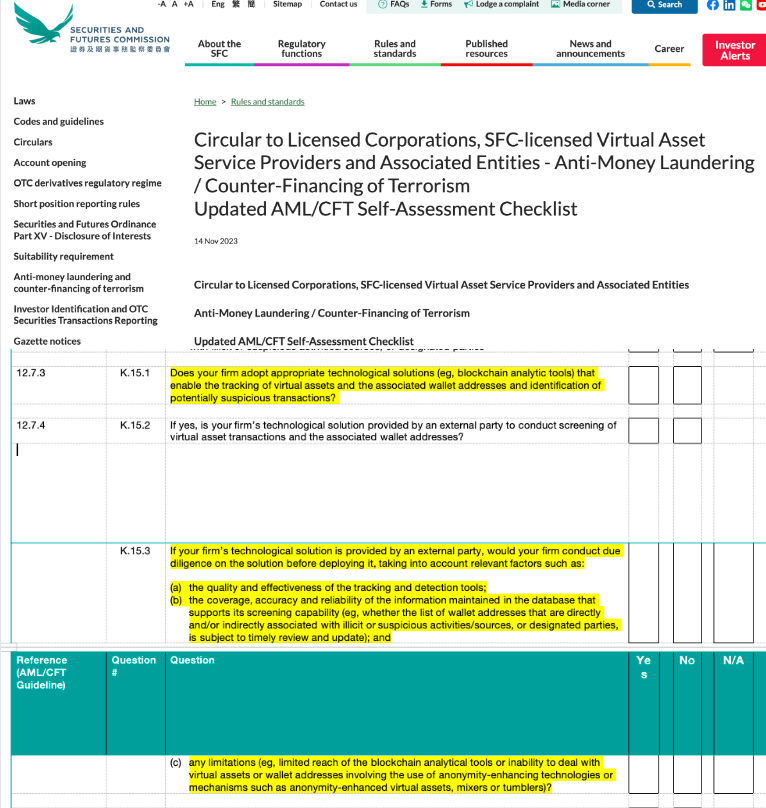OKLink: A Must-Have for On-Chain Trading Compliance from the Latest Documents of Hong Kong SFC
Author: Hedy Bi, OKLink Research Institute

Recently, the Hong Kong Securities and Futures Commission (SFC) published a circular on its official website titled "To Licensed Corporations, Licensed Virtual Asset Service Providers, and Related Entities - Updated Self-Assessment Checklist for Anti-Money Laundering/Counter-Terrorist Financing," which reiterates the importance of blockchain analysis tools in the updated self-assessment checklist. Specifically, the SFC emphasizes the significance of blockchain analysis tools in the section on "Ongoing Monitoring Related to Virtual Asset Transactions and Activities."
The purpose of this circular is to "establish a comprehensive framework for self-assessing compliance with the key requirements of anti-money laundering and counter-terrorist financing." Compared to the version used in 2022, a new section K) on virtual assets has been added.

I. Blockchain Analysis Tools "Pass the Test"
This is not the first time the Hong Kong SFC has proposed technological solutions related to blockchain analysis tools.
Blockchain analysis tools have long been essential compliance tools for virtual asset service providers internationally. Hong Kong regulators have gradually recognized their importance: since the beginning of this year, the SFC has been consulting the public on the "Proposed Regulatory Framework for Licensed Virtual Asset Trading Platform Operators," which did not mention blockchain analysis tools.
In its recommendations, the OKLink Research Institute analyzed the on-chain world, including on-chain transfers and interactions, using the OKLink Onchain AML technology solution as an example, and suggested that "financial institutions should adopt appropriate technological solutions (such as blockchain analysis tools) to track virtual assets and related wallet addresses and identify potential suspicious transactions."
In June of this year, the SFC updated the "Consultation Summary on Proposed Regulatory Framework for Licensed Virtual Asset Trading Platform Operators," adding Appendix B - Chapter 12 on Virtual Assets, where blockchain data analysis tools were particularly emphasized in the newly added footnote 12.7.3 with 134 entries. The updates on November 14 to the "Self-Assessment Checklist for Anti-Money Laundering/Counter-Terrorist Financing" indicate that the SFC hopes virtual asset service providers will adopt blockchain data analysis tools and other technological solutions to proactively mitigate money laundering risks.

II. On-Chain Transactions: A Focus for the Hong Kong SFC
Virtual assets and on-chain transactions are innovative and highly complex, with technical characteristics that significantly differ from traditional financial products. This makes traditional regulatory approaches difficult to apply directly to the regulation of on-chain transactions, prompting the Hong Kong SFC to propose a comprehensive regulatory framework in June of this year, with special attention given to "on-chain transactions," which differ from traditional financial products. Why is the Hong Kong SFC focusing on on-chain transactions?
Large Transfers Favor On-Chain Transactions
Large transactions typically involve higher risks, including money laundering, fraud, and market manipulation, making them a regulatory focus in both traditional finance and the virtual asset market. Most large transfer transactions are not conducted on centralized trading platforms but are completed between wallets. On-chain transfers and transactions often have anonymity and resistance to censorship, which complicates regulation.
Data analysis from the OKLink blockchain explorer shows that, aside from the fund flows between exchange accounts and market makers, large transactions from personal accounts are mostly conducted on-chain rather than on centralized exchanges.
Money Laundering Crimes are Evolving
Compared to traditional money laundering crimes, those using crypto assets are more covert and difficult to trace. Due to their technical characteristics, they can play different roles in the three stages of money laundering crimes—placement, layering, and integration. Additionally, there are instances where criminals steal legitimate users' accounts to facilitate money laundering.
The FATF's report "Money Laundering Using New Payment Methods" mentions that online payment methods are often used to launder illegal proceeds from identity theft fraud or to steal funds from bank accounts, credit cards, or debit cards through hacking, phishing, and other means; and to transfer these illicit funds to untraceable locations using the anonymity of cryptocurrencies. This is because most cryptocurrency transactions do not require face-to-face contact, providing opportunities for individuals to abuse their legitimate accounts for money laundering.
III. On-Chain Anonymity vs. On-Chain Transparency
On-chain anonymity does not equate to difficult regulation. While blockchain technology brings features like anonymity, its immutability and transparency allow every on-chain transaction to be verified and traced on the blockchain. Transaction records are permanently recorded in a distributed blockchain network, making them difficult to alter or delete. This enables regulators to more accurately track the flow of funds and identify suspicious transactions and money laundering activities.
Therefore, blockchain analysis tools have become the preferred choice for the industry to efficiently interpret on-chain data. By analyzing transaction patterns, address associations, and fund flows, these tools can identify abnormal patterns and risk indicators, providing clues and decision support for regulators and virtual asset service providers.
SFC Chief Executive Ashley Alder stated that the regulation of virtual assets by the Hong Kong SFC is aimed at investor protection, and regarding tools, he mentioned, "With new technologies, there are certainly new risks, so we must minimize risks as much as possible and have new tools to address new risks to enjoy the benefits that new technologies bring to financial services."
As the recognition and demand for blockchain analysis tools increase among regulators and virtual asset service providers, this field will see more investment and innovation. For companies in other sectors, entrepreneurs, and even retail investors, as the industry actively explores and applies blockchain data analysis tools, they can better understand and manage the risks of virtual asset transactions. For instance, OKLink provides various tools that allow investors to easily understand transaction data and on-chain activities, enabling retail investors to better assess the reliability and risk levels of projects and make more cautious investment decisions.

Using new tools to address new risks, blockchain analysis tools have become essential. Only with the speed of Hong Kong and a proactive risk management approach can we effectively achieve investor protection and promote the healthy development of Web3.









